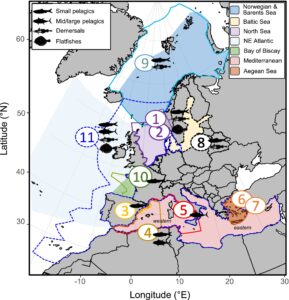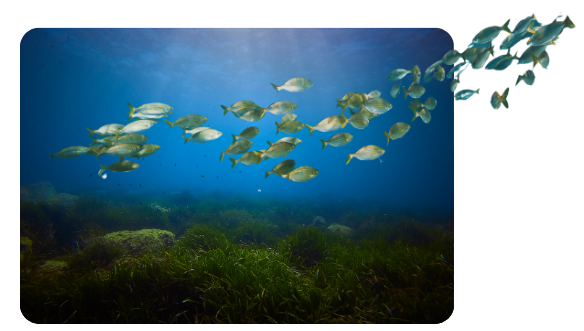Story
Climate Change to Reshape European Fisheries: New Study Maps "Winners and Losers"
11 April 2025
First multi-model analysis shows dramatic shifts in commercial fish stocks by the end of the century

Atlantic/North Sea cod (Gadus morhua). Courtesy of Erling Svensen/IMR
A new study, led by Plymouth Marine Laboratory (PML) in collaboration with marine scientists from across Europe, reveals the extent to which climate change is set to significantly alter the distribution and abundance of commercially important fish species across European seas over the coming decades.
The paper “Multiple Models of European Marine Fish Stocks: Regional Winners and Losers in a Future Climate”, published in Global Change Biology, represents the first comprehensive, multi-model assessment of how 18 key fish stocks will respond to warming waters across seven European regional seas from the Mediterranean to the Arctic by 2100.
The research has profound implications for fishing communities and economies throughout the region.
“Our analysis shows that the overall productivity and biomass of these crucial species are projected to decline within European waters by at least 15% by 2050 under moderate emissions scenarios, and by over 40% by 2100 under high emissions scenarios,” explains lead author PML’s Dr. Sévrine F. Sailley.
“However, these changes won’t be uniform – we’re seeing a complex patchwork of ‘winners and losers’ depending on the species and region.”
The international research team employed eleven state-of-the-art bio-ecological models to project how fish stocks will respond to changes in sea surface temperature, primary productivity, and other environmental factors under different climate scenarios.

Dr Martin Huret, co-author and Fisheries Researcher at Infremer (France), explains more about the models used:
“The models were of different nature and structure, with different levels of mechanisms and complexity included. This provided a spectrum of ecological responses and helped inform the level of uncertainty associated with the future trajectories of fish stocks.”
Rather than focusing on total biomass or catch potential, as most previous studies have done, the research examined individual commercially valuable species across relevant spatial scales.
Regional Impacts Vary Dramatically
The study found that valuable cold-water species like herring, cod, and haddock are projected to decline in the North Sea by 10-20% under moderate warming scenarios and by 10-80% under high emissions scenarios by 2100.
Meanwhile, some warm-water species in the Mediterranean, such as dolphinfish, may actually benefit from warming waters if properly managed.
One of the study’s most striking findings is how fish distributions will shift as species follow their preferred temperature ranges. In the Northeast Atlantic, most species will migrate northward, with shifts ranging from just a few kilometres for haddock (3-25 km) to over 400 km for herring (230-430 km) by 2100. In the Mediterranean Sea, shifts will occur primarily along an east-west gradient, with changes in centroid location ranging from 2 to 786 km depending on the species.
“These distributional shifts could be even more critical to fisheries than changes in abundance,” notes Dr. Sailley. “When fish move, fishers must either travel further to catch them – increasing fuel costs and time at sea – or adapt by targeting different species. Both options have significant economic implications.”

The economic stakes are particularly high for the European Union, as the world’s largest single market for fish and fish products. The EU aims to effectively manage its fish stocks and sustainably grow its aquaculture sector to promote self-sufficiency in the domestic supply of fish and seafood, but climate change poses both risks and potential opportunities to these goals.
Climate-Ready Fisheries Management
The study underscores that the fishing industry can adapt to these changes, but only with forward-looking management strategies. This includes cross-boundary management between countries for stocks that occur across multiple Exclusive Economic Zones (EEZs).
“Climate adaptation will require adopting new fishing gear designs, gaining experience fishing ‘new’ species, and developing new markets,“ Dr. Sailley explained.
“The traditional targets of small pelagic fisheries like sardine and anchovy in the Western Mediterranean are projected to decline severely under warming scenarios, but enhanced habitat suitability for tropical to sub-tropical species like sardinella may partly compensate for these losses.”
Traditional fisheries management frameworks based on historical data and static stock boundaries will become increasingly inadequate as species distributions shift. The authors recommend incorporating climate projections into fisheries management planning and argue that robust projections from regional models can provide the best underpinning to planning actions to successfully meet key policy objectives such as the United Nations Sustainable Development Goals (SDGs).
Dr. Katell Hamon, co-author and Senior Scientist on Fisheries Economics and Behaviour at Wageningen University & Research (Netherlands), commented:
“Projecting where the commercial fish stocks are is a crucial step to inclusive management. On the international scale, it will help us anticipate potential conflicts between users and hopefully put strategies in place to avoid those conflicts. On the more local scale, the next steps include trans-disciplinary approaches with models better capturing how fishers can react to maintain a fishing activity which is crucial for the livelihood of the fishing communities.”
The authors conclude: “To address critical concerns such as food security, employment, and the cultural significance of fisheries, we recommend that future efforts prioritize the development of multi-model, regional projections of fish stocks as a global imperative”.
The publication was led by PML, with support from:
- Mediterranean Institute for Advanced Studies (IMEDEA, CSIC-UIB), Esporles, Spain
- Wageningen Marine Research, Wageningen University and Research, IJmuiden, the Netherlands
- Technical University of Denmark, National Institute for Aquatic Resources, Kongens Lyngby, Denmark
- Nippon Foundation Ocean Nexus, School of Resource and Environmental Management (REM), Simon Fraser University (SFU), Burnaby, British Columbia, Canada
- Hellenic Centre for Marine Research (HCMR), Anavyssos, Greece
- Institute of Marine Research (Havforskningsinstituttet) (IMR), Bergen, Norway
- DECOD (Ecosystem Dynamics and Sustainability), IFREMER, INRAE, Institut Agro, Brest, France
- Centre for Environment, Fisheries and Aquaculture Science (Cefas), Lowestoft, UK
- Wageningen Economic Research, Wageningen University and Research, Wageningen, the Netherlands
- Department of Coastal Systems, Royal Netherlands Institute for Sea Research (NIOZ), Den Burg (Texel), the Netherlands
Related information
Full paper: “Multiple Models of European Marine Fish Stocks: Regional Winners and Losers in a Future Climate”
